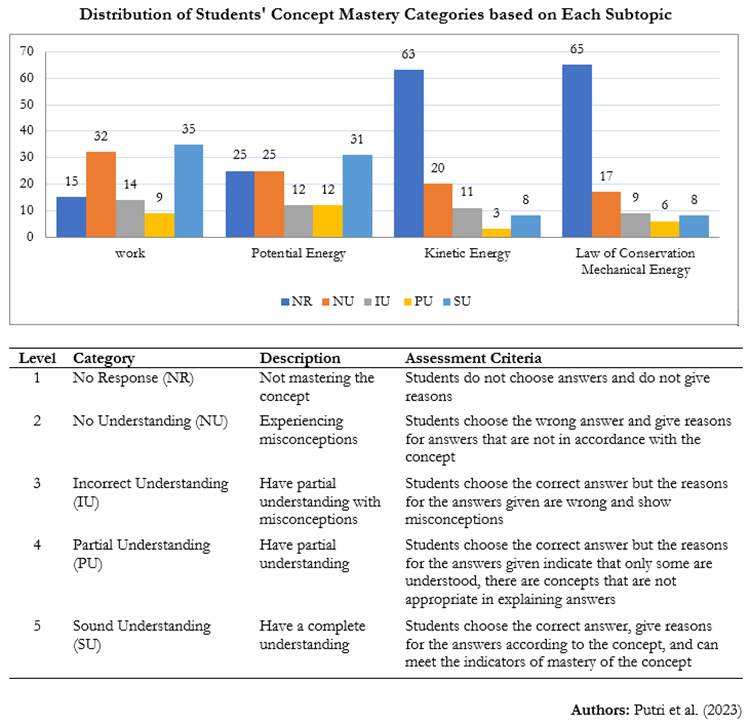
Exploring High School Students' Concept Mastery of Work and Energy Topics: A Quantitative Descriptive Study with Insights for STEM Learning
Abstract
This quantitative descriptive study investigates the concept mastery of work and energy among high school students, specifically focusing on 105 students from the XI MIPA Laboratory UM High School. The research employs a concept mastery test, adapting Bloom's taxonomy indicators from C2 to C6, comprising 15 reasoned multiple-choice questions with a reliability value of 0.704. Student responses, categorized into No Response (NR), No Understanding (NU), Incorrect Understanding (IU), Partial Understanding (PU), and Sound Understanding (SU), reveal a prevalent mastery level in the category of Incorrect Understanding or partial comprehension of misconceptions. Specifically, NR, NU, IU, PU, and SU categories are reported at 4.76%, 39.05%, 52.38%, 3.81%, and 0%, respectively. Subtopics such as work-potential energy and kinetic energy-conservation of mechanical energy law fall within the IU and NU categories. The findings emphasize the need for a tailored learning model addressing misconceptions and aligning scientific explanations with everyday experiences. This study underscores the importance of incorporating learning cycle methodologies, STEM approaches, and formative assessment strategies to enhance students' comprehension of work and energy concepts.
Keywords
Full Text:
PDFReferences
Barniol, P., & Zavala, G. (2014). Force, velocity, and work: The effects of different contexts on students’ understanding of vector concepts using isomorphic problems. Physical Review Special Topics-Physics Education Research, 10(2), 020115. https://doi.org/10.1103/PhysRevSTPER.10.020115
Bécu‐Robinault, K., & Tiberghien, A. (1998). Integrating experiments into the teaching of energy. International Journal of Science Education, 20(1), 99–114. https://doi.org/10.1080/0950069980200107
Bloom, B. S. (2010). A taxonomy for learning, teaching, and assessing: A revision of Bloom's taxonomy of educational objectives. London, England: Longman.
Büyükdede, M., & Tanel, R. (2019). Effect of the STEM activities related to work-energy topics on academic achievement and prospective teachers' opinions on STEM activities. Journal of Baltic science education, 18(4), 507–518. https://doi.org/10.33225/jbse/19.18.507
Chen, R. F., Eisenkraft, A., Fortus, D., Krajcik, J., Neumann, K., Nordine, J., & Scheff, A. (Eds.). (2014). Teaching and learning of energy in K-12 education. Cham, Switzerland: Springer International Publishing.
Dalaklioğlu, S., Demirci, N., & Şekercioğlu, A. (2015). Eleventh grade students’ difficulties and misconceptions about energy and momentum concepts. International Journal of New Trends in Education and Their Implications, 6(1), 13–21.
Docktor, J. L., & Mestre, J. P. (2014). Synthesis of discipline-based education research in physics. Physical Review Special Topics-Physics Education Research, 10(2), 020119. https://doi.org/10.1103/PhysRevSTPER.10.020119
Jewett Jr, J. W. (2008). Energy and the confused student II: Systems. The Physics Teacher, 46(2), 81–86. https://doi.org/10.1119/1.2834527
Kim, E., & Pak, S. J. (2002). Students do not overcome conceptual difficulties after solving 1000 traditional problems. American Journal of Physics, 70(7), 759–765. https://doi.org/10.1119/1.1484151
Kohl, P. B., & Finkelstein, N. D. (2008). Patterns of multiple representation use by experts and novices during physics problem solving. Physical review special topics-Physics education research, 4(1), 010111. https://doi.org/10.1103/PhysRevSTPER.4.010111
Kurnaz, M. A., & Arslan, A. S. (2014). Effectiveness of multiple representations for learning energy concepts: Case of Turkey. Procedia-Social and Behavioral Sciences, 116, 627–632. https://doi.org/10.1016/j.sbspro.2014.01.269
Lin, S. Y., & Singh, C. (2013). Using an isomorphic problem pair to learn introductory physics: Transferring from a two-step problem to a three-step problem. Physical Review Special Topics-Physics Education Research, 9(2), 020114. https://doi.org/10.1103/PhysRevSTPER.9.020114
Lindsey, B. A., Heron, P. R. L., & Shaffer, P. S. (2009). Student ability to apply the concepts of work and energy to extended systems. American Journal of Physics, 77(11), 999–1009. https://doi.org/10.1119/1.3183889
Liu, X., Ebenezer, J., & Fraser, D. M. (2002). Structural characteristics of university engineering students' conceptions of energy. Journal of Research in Science Teaching: The Official Journal of the National Association for Research in Science Teaching, 39(5), 423–441. https://doi.org/10.1002/tea.10030
Maryana, A. & Dwikoranto. (2017). Effectiveness of Concept attainment model based on multiple representation to conceptual understanding and scientific consistency of student on work and energy topic. Jurnal Inovasi Pendidikan Fisika (JIPF), 6(3), 301–307. https://doi.org/10.26740/ipf.v6n3.p%25p
Moodley, K., & Gaigher, E. (2019). Teaching electric circuits: Teachers’ perceptions and learners’ misconceptions. Research in Science Education, 49, 73–89. https://doi.org/10.1007/s11165-017-9615-5
Mungan, C. E. (2005). A primer on work-energy relationships for introductory physics. The Physics Teacher, 43(1), 10–16. https://doi.org/10.1119/1.1845983
Murdoch, J. (2018). Our preconceived notions of play need to challenging. Early Years Educator, 19(9), 22–24. https://doi.org/10.12968/eyed.2018.19.9.22
Mustofa, Z., Sutopo, S., Mufti, N., & Asmichatin, A. (2019). The impact of modeling instruction based on system toward work-energy concept understanding. Jurnal Penelitian & Pengembangan Pendidikan Fisika, 5(2), 145–154. https://doi.org/10.21009/1.05209
Olaoluwa, A. M., & Olufunke, T. (2015). Relative effectiveness of learning-cycle model and inquiry-teaching approaches in improving students’ learning outcomes in physics. Journal of Education and Human Development, 4(3), 169–180. http://doi.org/10.15640/jehd.v4n3a18
Park, M. (2020). Seeing the forest through the trees using network analysis: Exploring student responses to conceptual physics questions. Journal of Science Education and Technology, 29(5), 605–621. https://doi.org/10.1007/s10956-020-09840-w
Pramesti, Y. S., Mahmudi, H., & Setyowidodo, I. (2020). Analyzing students’ understanding of work-energy concept. Journal of Physics: Conference Series, 1521(2), 022016. https://doi.org/10.1088/1742-6596/1521/2/022016
Rizaldi, D. R., Doyan, A., Makhrus, M., Fatimah, Z., & Nurhayati, E. (2021). Adaptation to new normal conditions: Students physics learning outcomes using the blended learning model. International Journal of Asian Education, 2(3), 369–376. https://doi.org/10.46966/ijae.v2i3.171
Saglam-Arslan, A., & Devecioglu, Y. (2010). Student teachers' levels of understanding and model of understanding about Newton's laws of motion. Asia-pacific Forum on science learning & Teaching, 11(1), 1–20.
Sağlam-Arslan, A., & Kurnaz, M. A. (2009). Prospective physics teachers' level of understanding energy, power and force concepts. Asia-Pacific Forum on Science Learning & Teaching, 10(1), 1–18.
Santhalia, P. W., & Yuliati, L. (2021). An exploration of scientific literacy on physics subjects within phenomenon-based experiential learning. Jurnal Penelitian Fisika dan Aplikasinya (JPFA), 11(1), 72–82. https://doi.org/10.26740/jpfa.v11n1.p72-82
Jurnal Pendidikan Sains Journal of Science, Mathematics, and Vocational Education Graduate School Of Universitas Negeri Malang JPS is licensed under Creative Commons Attribution-ShareAlike 4.0 International License |







